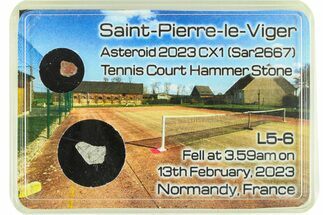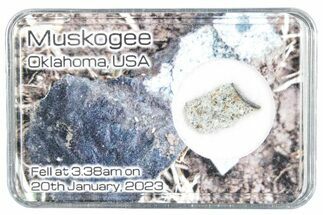.15" L5-6 Chondrite Meteorite Hammer Stone - Saint-Pierre-le-Viger
This is a fragment from the L5-6 chondrite known as Saint-Pierre-le-Viger, which fell a French commune of the same name on February 13, 2023. This meteorite (larger circle) is a hammer stone, a unique form of meteorite that hits man-made objects and retains traces of those impacts. This particular specimen hit a tennis court!
This specimen comes in its own labeled display case.
This specimen comes in its own labeled display case.
What Is A Hammer Stone?
Hammer stones are the names given to meteorite fragments that hit man-made objects, animals, or people when they fall. Hammer stones are often identified by the scuffed fusion crusts that can contain traces of paint, rubble, or other materials from the objects they hit. Because they are so rare, they are valued collectors' items. Often the items hammer stones hit go up in value, just be being damaged by a meteorite!
Hammer stones are the names given to meteorite fragments that hit man-made objects, animals, or people when they fall. Hammer stones are often identified by the scuffed fusion crusts that can contain traces of paint, rubble, or other materials from the objects they hit. Because they are so rare, they are valued collectors' items. Often the items hammer stones hit go up in value, just be being damaged by a meteorite!
The meteorite known as Saint-Pierre-le-Viger is an L5-6 chondrite with a well-documented, witnessed fall near a commune of the same name in France in 2023.
Hungarian astronomer Krisztián Sárneczky first tracked an asteroid making its way towards earth around 8:15 PM local time on February 12. Between his observatory station in the Mátra Mountains of Hungary and the Croatian Višnjan Observatory, they estimated that the asteroid would fall in Normandy, France. This was well-tracked by France's own network of bolide-tracking cameras and scientific institutions, known as the Fireball Recovery and Inter-Planetary Observation Network (FRIPON). FRIPON teams made it to the recovery site the next day, and the first fragment was found by an art student on the 15th. Subsequent found fragments were given to FRIPON for research dissemination. Most fragments including the main mass are held in French scientific collections, but some fragments like these have made their way onto the private market.
This meteorite displays a unique double-layered fusion crust, and even rare triple layers! The largely olivine interior is heavily shocked with scarce chondrules.
Hungarian astronomer Krisztián Sárneczky first tracked an asteroid making its way towards earth around 8:15 PM local time on February 12. Between his observatory station in the Mátra Mountains of Hungary and the Croatian Višnjan Observatory, they estimated that the asteroid would fall in Normandy, France. This was well-tracked by France's own network of bolide-tracking cameras and scientific institutions, known as the Fireball Recovery and Inter-Planetary Observation Network (FRIPON). FRIPON teams made it to the recovery site the next day, and the first fragment was found by an art student on the 15th. Subsequent found fragments were given to FRIPON for research dissemination. Most fragments including the main mass are held in French scientific collections, but some fragments like these have made their way onto the private market.
This meteorite displays a unique double-layered fusion crust, and even rare triple layers! The largely olivine interior is heavily shocked with scarce chondrules.
What Is An L5 Chondrite?
An L5 chondrite is a type of stony meteorite that falls under the "L" (low iron) chondrite group. L chondrites have lower iron content (around 7-11% iron, mostly in the form of iron sulfide or silicates) and typically show less metal than H chondrites (high iron chondrites). They primarily consist of silicate minerals like olivine and pyroxene.
The "5" rating indicates a high degree of thermal metamorphism. This means that the L5 chondrite experienced substantial heating, likely on its parent asteroid, which caused partial recrystallization of minerals. As a result, the original chondrules (small, rounded particles) are less distinct and partially altered, though still visible. L5 chondrites usually have a light to medium gray matrix, and the chondrules tend to be less clearly defined due to metamorphic alteration. You may still see rounded chondrule outlines, but they appear partially integrated with the surrounding matrix.
The L chondrite group is believed to come from a specific parent body in the asteroid belt, which likely experienced a major collisional event. This event may have sent large quantities of L chondritic material into space, resulting in the abundance of L chondrites found on Earth.
An L5 chondrite is a type of stony meteorite that falls under the "L" (low iron) chondrite group. L chondrites have lower iron content (around 7-11% iron, mostly in the form of iron sulfide or silicates) and typically show less metal than H chondrites (high iron chondrites). They primarily consist of silicate minerals like olivine and pyroxene.
The "5" rating indicates a high degree of thermal metamorphism. This means that the L5 chondrite experienced substantial heating, likely on its parent asteroid, which caused partial recrystallization of minerals. As a result, the original chondrules (small, rounded particles) are less distinct and partially altered, though still visible. L5 chondrites usually have a light to medium gray matrix, and the chondrules tend to be less clearly defined due to metamorphic alteration. You may still see rounded chondrule outlines, but they appear partially integrated with the surrounding matrix.
The L chondrite group is believed to come from a specific parent body in the asteroid belt, which likely experienced a major collisional event. This event may have sent large quantities of L chondritic material into space, resulting in the abundance of L chondrites found on Earth.
$45
TYPE
L5-6 Chondrite
LOCATION
Saint-Pierre-le-Viger, Normandy, France
SIZE
.15" wide
CATEGORY
ITEM
#285754
 Reviews
Reviews









